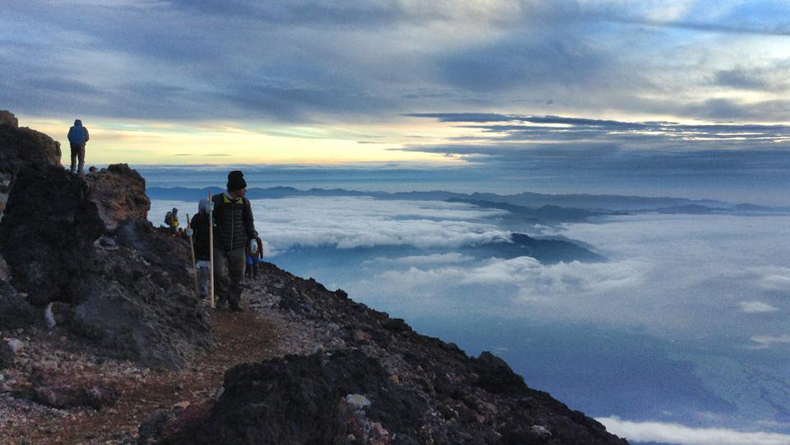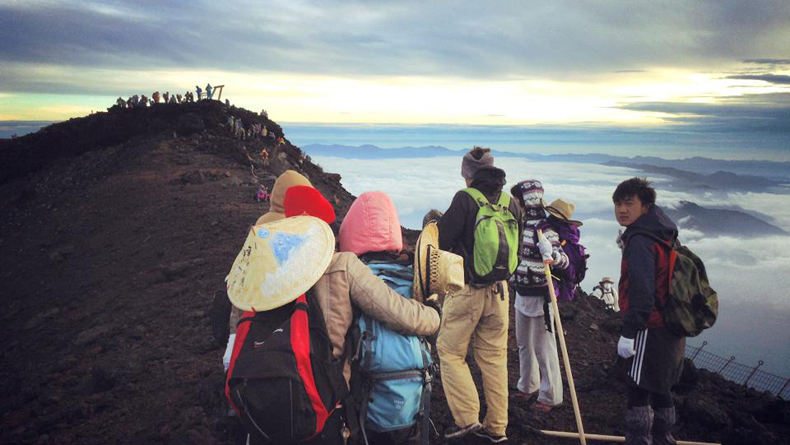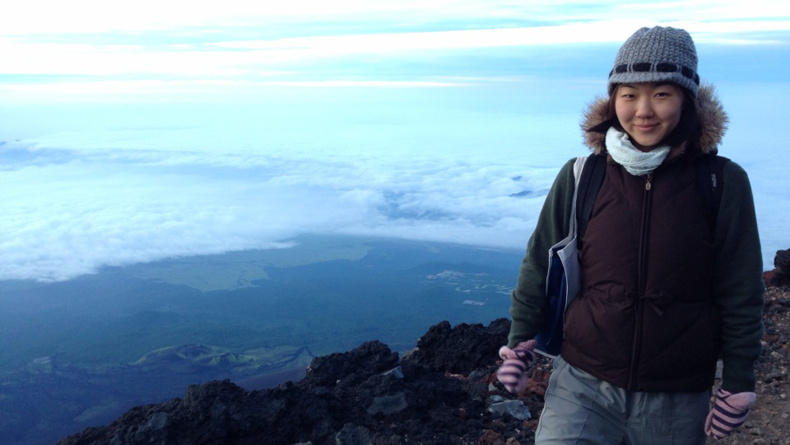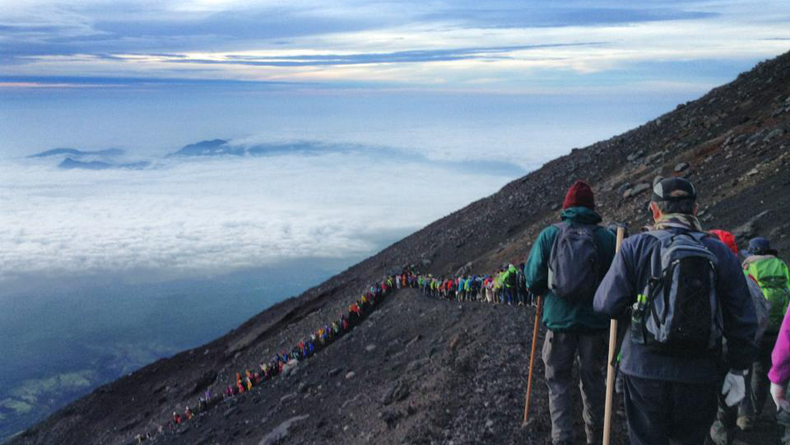Journey to the Summit of Mt. Fuji
Mount Fuji: the mere mention of this iconic name resonates awe and admiration in the hearts of tourists, locals and hardcore mountaineers alike. Topping out at a height of 3,776 meters, Japan's tallest peak and still-active volcano had a record-breaking increase in climbers since UNESCO bestowed it with World Heritage status earlier this summer.
Some friends and I decided to make the ultimate trek the weekend before Mt. Fuji officials enacted the ¥1,000 admission fee (so we can brag to our friends that not only did we climb the tallest mountain in Japan, we also saved money). We knew that particular weekend would be insanely crowded; Kyodo News recently reported that the number of Mt. Fuji trekkers in the first three weeks of official climbing season was 35 percent higher than the previous record, set it 2010.
This being our first attempt to climb Mt. Fuji, we made the big newbie mistake of being completely unprepared prior to the big day. We had spent a couple weeks “researching,” which basically meant reading things online and then sharing the advice in a long, messy Facebook group chat. Among ourselves we were both over and underprepared; some of us didn’t even bring long pants, while others bought expensive hiking boots solely for the trip. I brought a backpack stuffed with supplies, but it wasn’t enough, as I would later discover during the harsher moments of the trek.
Here is a list of the clothes I brought for the trip: bike shorts, snow pants, plain socks, winter socks, winter headband/scarf, winter beanie, plain t-shirt, plain long-sleeved shirt, Heattech long-sleeved t-shirt, sweatshirt, hoodie, down vest and tennis shoes. I also brought a two-liter water bottle, three rice balls, one energy drink, a loaf of garlic bread, and a small sandwich pack. At the mountain’s fifth station gift shop, I bought a Mt. Fuji walking stick—on which you can collect branded stamps at each station for a small price—and a Mt. Fuji cap.
So at 1 p.m. on a Saturday, all seven of us carrying bags packed to the brim, we were out of our rental car and on our way up the slope from the fifth station starting point. Maybe it was the theme park feel of the crowd, or the relaxing two-hour road trip from Tokyo, but considering the fact that only one of us stretched beforehand, I doubt we were truly aware of how daunting the next 7.5 kilometers were going to be.
The first part of the trip was nothing out of the ordinary; for the most part, we were stuck in a long, slow-moving line not unlike riding up crowded Tokyo escalators. The views were nicer of course, but I basically just focused on my footing and the seemingly increasing weight of my backpack.
Most people climb up the mountain during the day, rest at a hut for a few hours, see the sunrise, and then climb down. This is the safest and smartest way to do it. Timing is everything for making or breaking this experience. As Fuji newbies, my friends and I made the silly yet dangerous assumption that our hard heads and strong wills would be enough to get us up and down the mountain without having to fork over ¥6,000 to ¥8,000 for the couple-hour stay at a hut. According to the Ministry of the Environment, this “two-day and no-night” climbing plan, or “bullet climbing” accounts for roughly 28 percent of first-time Fuji climbers, most of them silly foreigners like ourselves.
At the 8.5 station, with the temperature falling like quicksand and the light in the sky dimming, we did a naive “we can do it!” cheer and kept going. Three hundred meters later, we were all separated, with the unsympathetic sun long departed and winds screaming into our pounding heads, sucking the air out of our high-altitude-affected lungs. Every step was unbearably slow and took at least a couple of shallow painstaking breaths. Luckily my boyfriend and I had half a loaf of garlic bread left between us, which gave us some much-needed energy to move forward. As we were getting higher and more exhausted, I could almost hear the very loud and anxious thought that was probably also distracting my boyfriend’s mind—what if there’s no hut at the top? We hadn’t bothered to find out. Yet we were going strong, and made it to the top before anyone else in our group. To our relief there was a hut waiting for us, providing the only light among the other tiny wooden shops that aligned the noticeably flat and empty road. That and the vending machine, which glowed like an alien promising the heavenly relief of bottled, chilled drinks for an unearthly ¥500.
That last couple hundred meters were so surreal; earlier that day I was dozing on the Yamanote Line squished among my fellow city dwellers, now I was inching my way up this barren, lifeless, and not to mention bone-chilling summit with my senses acutely attuned to every minute detail of my surroundings. Thinking back, that unpredictable last stretch was the best part of my Fuji trip, and I savored the memory dearly as I sat in my office at work the next day.
Undoubtedly, the very worst part of the trip was getting altitude sickness. As we were trying to get some shut-eye in the hut’s sleeping quarters, which was basically a long, two-level room lined with rows of mismatched futon blankets and tiny bean-filled pillows, most members of my group were overcome not by blissful sleep, but by an unbearable wave of altitude sickness. One of my friends vomited quietly in the faucet-less bathroom, and for the next few hours all we could do was try to ignore our pounding heads, overheated bodies, and oxygen-deficient lungs that were plaguing our precious sleep time. After five hours of attempting to sleep, our bodies started to acclimatize right as the lights turned on and it was time to see the sunrise at 3 a.m.
The hut’s lounge area, which was empty and dark when we arrived at 8 p.m., was now packed with hikers in colorful parkas who either stayed the night in the hut or ascended the mountain overnight. The hut keepers were busily serving salty bowls of ramen and tonjiru (miso soup with vegetables and pork), and the aromas of steam billowed into our faces as we devoured our first hot meal since leaving civilization. My ramen was far from perfect—noodles too chewy, broth too salty, and the braised bamboo shoots too rubbery—but I finished my bowl to the last drop, overwhelmed with satisfaction.
Outside it was still dark, but the summit was brimming with hikers. I could barely move through the swarms; we finally squeezed our way to a less populated area and hunkered down behind a ledge to catch the day’s first rays of light. As the sun finally began to peek out of the clouds and cameras clicked furiously into the void, my group and I, along with the hundreds of other shivering hikers, sighed in exalted awe at the scene before us. We did it. This is awesome. We are awesome. Now it’s time to go home.
The queue going down the mountain was just as crowded and steep as it was going up, yet everyone was practically skipping through the massive quantities of dust in a race to the bottom. I saw many people lose footing and slip painfully onto their bottoms, myself gaining a few scratches and bruises as well. The three and a half hours it took to reach our car flew by as we laughed and chatted energetically about all sorts of random topics. I think I was singing Disney songs at the last half hour mark; perhaps the heat and exhaustion was making me a little delirious. Nevertheless, by the time I was soaking in a heavenly hot spring at the nearby Yurari Onsen, with a spectacular view of the now defeated beast of a mountain, I was already anchoring the experience as a treasured memory that will most likely to be recalled for a lifetime.
Things You Don’t Need To Worry About
A walking stick. Honestly I used up more energy dealing with the hassle of carrying it up and down the mountain than I would have if I just used my arms by themselves. The gravel is so loose that the stick barely gave any support. But after the trip it will make a sweet trophy of your badassery and a pretty good laundry hanger.
Wifi. There is good, fairly reliable service at the summit, which is why you probably see a lot of Facebook posts from the top of the mountain.
Bathroom fees. Many Mt. Fuji websites and forums warn climbers to bring extra change for the ¥200-¥300 bathroom fee, but most of the toilets are actually donation-based, and many people ignore that too. However, most bathrooms don’t have running water, so it’s a good idea to bring a pack of wet wipes.
People warned me about not wearing proper hiking boots, but luckily the weather was decent enough for my cheap tennis shoes to pull through just fine. However, I do regret not bringing a towel, mittens, wet-wipes, and a sweat-proof undershirt. Luckily my friend had an extra towel, which proved super handy to wipe the never-ending sweat, dust, and snot (yes, get ready for that) from my face, and I had to resort to using my winter socks as mittens.
If you missed Mt. Fuji’s short climbing season or if you’d prefer a trek that is closer to the city and a bit less hardcore, consider climbing Mt. Takao instead.
The Deets
Getting There: Driving from Tokyo to the fifth station was the easiest, cheapest, and most relaxing way for my climbing group and I to get to Fuji, and many rental agencies in Tokyo don’t even require a reservation. The price per person of course depends on how many people are carpooling, and usually the rate becomes much cheaper if someone has a Japanese driver’s license rather than an international one. The cheapest service we found was Niko Niko Rent-a-Car, which has a base rate of ¥2,525 per 12 hours for a small van, plus gas. However, if you don’t want to deal with a Japanese-only website, Toyota Rent-A-Car is available in English.
If driving isn’t an option, you can make a reservation here for a one-way ticket (¥2,600) on a two-and-a-half hour direct bus ride from Shinjuku’s west exit to Mt. Fuji’s fifth station. It departs Shinjuku every hour in the mornings and evenings, and departs the fifth station every hour from 10 a.m. to 3 p.m.
Getting Up: According to the official Fujiyoshida City webpage, the majority of people (around 60 percent of the total number of hikers per year), including first-timers and seasoned hikers, make their trek by way of the Yoshida Trail, starting from the fifth station. The Yoshida Trail is definitely the most well-equipped, including huts, first-aid stations, bathrooms, snack shops, and overpriced vending machines.
Accommodation: Don’t worry too much about making reservations at the huts. We winged it after being told by staff members that all were completely booked, but upon reaching each hut we were being beckoned in to fill up the many vacant spots still available. Each hut has a different price, with weekdays being cheaper than weekends, and the prices range from ¥6,000 (for the top summit hut) to roughly around ¥8,000, sometimes with meals included. The hours depend on the hut, but most close at around 9 or 10 p.m., so be wary of timing if you don’t want to spend the night exhausted and freezing.
After the Hike: I highly recommend soothing your aching muscles at Yurari Onsen after your trek. If you print the coupon from the spa’s homepage, you can save ¥200 on a ¥1,000 ticket. The camomile hot spring was perfect for my strained muscles and weather-beaten skin, and there is nothing more peaceful than soaking in an outdoor onsen (hot spring) while admiring a beautiful view of Mt. Fuji with your fellow mountaineers.
Text by Yulia Mizushima. Photos by Yulia Mizushima and Kai Jun.















